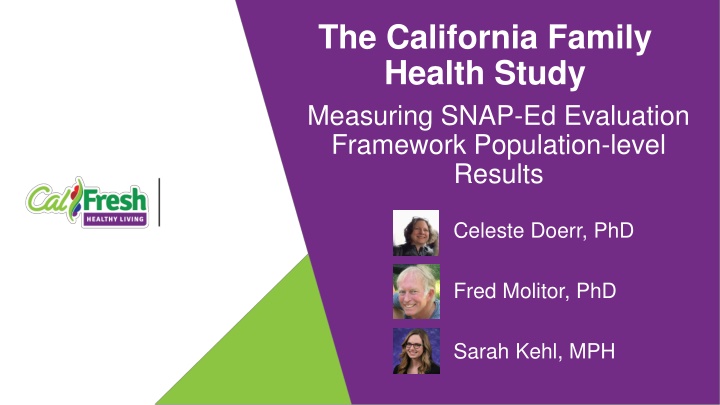
California Family Health Study: SNAP-Ed Evaluation Framework Results
"Explore the California Family Health Study focusing on evaluating SNAP-Ed programs to track population-level nutrition and physical activity behaviors. Learn about data sources, sampling methods, and tools used for an in-depth analysis. Discover the goals, expansion, and outcomes of this statewide initiative launched in 2013."
Uploaded on | 0 Views
Download Presentation

Please find below an Image/Link to download the presentation.
The content on the website is provided AS IS for your information and personal use only. It may not be sold, licensed, or shared on other websites without obtaining consent from the author. If you encounter any issues during the download, it is possible that the publisher has removed the file from their server.
You are allowed to download the files provided on this website for personal or commercial use, subject to the condition that they are used lawfully. All files are the property of their respective owners.
The content on the website is provided AS IS for your information and personal use only. It may not be sold, licensed, or shared on other websites without obtaining consent from the author.
E N D
Presentation Transcript
The California Family Health Study Measuring SNAP-Ed Evaluation Framework Population-level Results Celeste Doerr, PhD Fred Molitor, PhD Sarah Kehl, MPH
Introduction CalFresh Healthy Living: California s SNAP-Ed Program California s SNAP-Ed programming circa 2012-2013 o Primarily direct education o No SNAP-Ed Evaluation Framework o Leadership perceived a need to: show good program stewardship track population-level nutrition and physical- activity behaviors
Introduction Existing data sources oBehavioral Risk Factor Surveillance System Long-standing, national survey Nutrition module administered biennially (or purchased) Limited dietary data (e.g., 6 items for fruits and vegetables) oNational Health and Nutrition Examination Survey Also long-standing and national 24-hour dietary recall Minimizes biased reporting, increases accuracy Not representative at the state level oCalifornia Health Interview Survey Representative at state level Limited dietary data (subject to change)
Introduction California Family Health Study launched FFY 2013 oGoals: Designed to be representative at the state level Originally 17 largest counties Expanded to 30 counties in 2015 Expanded to all 58 counties in 2018 Flexibility to the program s changing information needs Extensive and high quality 24-hour dietary recall data Hoped to link program activities to healthful outcomes
Method Random Sampling oMedi-Cal Eligibility Data System sampling frame oHouseholds eligible for the CalFresh Food (SNAP) benefit With at least on one child or teen and one adult, female caregiver (Except in 2019, when men were included) Recruitment oIntroductory letter Interviews with adult caregiver and one child or teen oTrained interviewers call household to confirm eligibility (Call 1) Identify the child or teen (randomized using CATI)
Method Materials and Instruments oPacket mailed to household with Portion size booklet Measuring cups and spoons Tape measure oNational Cancer Institute s Automated Self-Administered 24-Hour Dietary Assessment System (ASA24) Modified for telephone interview administration in collaboration with codeveloper Westat Interviewers trained and monitored by California State University Sacramento nutrition professor oSupplemental interview with height, weight, physical activity, food security, demographics
Introduction Variables o Correspond to SNAP-Ed Evaluation Framework population- level indicators Health Eating Index scores Energy density Fruits and vegetables (FV) with and without 100% juice Grains whole and not whole Milk and dairy Water and sugar-sweetened beverages (SSB)s Food security Adopted the 6-item USDA ERS module in 2018 Physical activity Adults: Hours and minutes for most frequent two (and the activities for computing METS) Children/Teens: Days active 60+ minutes BMI and category
Highlights of Analyses and Results Direct-education reach analysis* oAdult, female caregivers (n = 6,355) who participated in FFY 2014 oRegressed cups of FV, cups of SSBs, and calories from high-fat foods on direct-education reach at the census tract level Controlled for race/ethnicity and education oWomen from census tracts with high reach vs. no/low reach consumed More cups of FV Fewer cups of SSBs Fewer calories from high-fat foods *Molitor, Sugerman, & Sciortino (2016)
Highlights of Analyses and Results Three-year trends, 2015 - 2017** Women (n = 13,247), teens (n = 3,293), and children (n = 6,043) Regressed FV, water, and SSBs on year Controlled for race/ethnicity and age, education (mothers), and gender (children/teens) No effect for SSBs Systematic follow-up comparisons across racial/ethnic groups disclosed a need for interventions directed at African American families California Department of Social Services has contracted PHI CWN for a formative study **Molitor, Doerr, Pugliese, & Whetstone (2019)
Discussion California Family Health Study results have Tied the reach of California s direct-education programming to low- income women s healthful behaviors Revealed improved dietary behaviors over time among low-income women and their teens and children Illuminated areas for development in 2020 and beyond Planned future directions include Investigation of PSE reach Dyadic analyses Obesity by racial and ethnic groups
California Department of Social Services Ana Bola os Samantha Trammell California State University, Sacramento Dr. Urvashi Mulasi Leigh Ann Green Dr. Mical Shilts Dr. Julia Tomassilli The dedicated interviewers at the Public Health Survey Research Program California Department of Public Health Dr. Ingrid Cordon Alexander Dr. John Pugliese Dr. Lauren Whetstone PHI Center for Wellness and Nutrition Amy DeLisio Emilie McClintic Brian Petrie Dr. Alondra Vega-Arroyo
